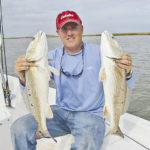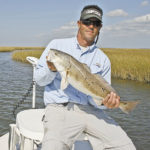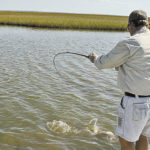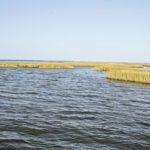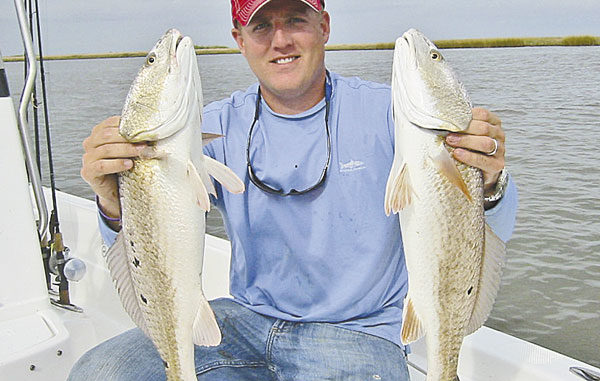
This time of year, cold fronts usually drive redfish out of the shallows and into bigger lakes and bays, where they could not be easier to catch.
Louisiana redfishing is often thought of as the baseball equivalent of small-ball. Tippy, skinny water boats slinking though ponds and broken marsh with a push pole or trolling motor at its lowest setting. Anglers peering through a half dozen species of submerged vegetation, trying to differentiate the colors and motions of the preferred prey from that of mullet, sheepshead and the similarly colored stingray. And then barely daring to utter a harsh whisper when pointing out the telltale push or bright-red pectoral fins before the blunt-nosed bayou brawler comes into full view.Cold fronts generally chase fish and their devotees from the shallows and into more of a game of power. Stiff north winds associated with these weather systems generally blow water out of the marshes and into the bigger lakes and bays dotting the fringe coastline.
Boats used for tackling summertime speckled trout with beefed-up 36-volt trolling motors are right at home tackling likely shorelines when the bluebird conditions following the passage of fronts present themselves.
Of course, it’s not as easy as simply heading to the nearest big body of water and putting the trolling motor down. But a little pregame preparation can go a long way in eliminating unproductive water.
“The first thing I’ll do is take a look at a map and look for the windward (rough) shoreline,” said Jason McCrossen, an avid redfish chaser from Gretna. “I find that in the colder time of the year, there seems to be more bait that is blown up on the shoreline. And anytime you’re looking for redfish, that’s the first thing you should think of — bait.”
McCrossen’s point about the near single-mindedness of a redfish is well-taken. Though they are fall spawners, they don’t generally reach sexual maturity and migrate into the Gulf of Mexico until they’re at least 27 inches long. So they’ve usually got one thing on their minds whether they’re in the farthest of backwater ponds or cruising the big water — eating enough to get to sexual maturity.
McCrossen talked about big water on a trip last year out of Empire’s Delta Marina with Louis Houvenaeghel. After taking a brief five-fish sampling of the region’s best-kept secret — the line of rocks to the left as one exits the Empire floodgates — we steered the Shearwater 22 into Bay Adams to see how the fish might react to the early fall chill. It was brisk enough to don jackets, a sure sign that a cold front had pushed through a few days prior. And though it would be warm enough for shirt sleeves later that day, the falling tide had the fish on the move as we searched irregular shorelines.
“What I really like to look for is more of a sharp dropoff instead of a typical gentle slope coming off of the bank,” said McCrossen. “The lower water this time of year really allows you to pick that up, especially when the water temperature drops and the water gets clear.”
Many cool-water enthusiasts believe the water clears in the wintertime due to it being heavier and slightly less susceptible to becoming choppy, much like offshore fishermen know that once they reach warmer blue water on winter trips, the swells get noticeably nastier.
Others believe that algae die-offs serve to clear up the murk often seen in warm weather. Regardless, McCrossen says it’s critical to not only spying fish to cast to, but in recognizing irregularities in the bottom structure.
“You’re always looking for something different for the fish to relate to,” he said. “A good dropoff can be a great place for a fish to cruise and pick off prey, and it’s something you’d have to really, really be looking for when the water is up. The dropoff might be 6 feet or more off the bank.
“The super-clear water and the lower water this time of year really lets you in on a lot of what’s on the bottom.”
McCrossen also believes in flats off of a bank that are near protected areas of deeper water. Though most big-water areas contain enough water to protect fish when temperatures plunge, they’re not exactly the kind of sanctuaries redfish — and the baitfish they subsist on — prefer.
We slid along a flat just off of Bay Adams as the sun peeked well above the horizon, warming the 18 inches of water. A ditch leading to an old pipeline canal lay ahead, and it was intersected by a trenasse that led to a system of ponds.
“This area is just what I’m talking about,” he said. “You’ve got a nice shallow flat that fish can work and a good stretch of calm, deep water in that trenasse there. It’s about 6 or 7 feet deep in there, plenty enough for redfish to get there and just survive if it gets cold.”
As curious as McCrossen was as to what the area had in store, he was more interested in the possibilities of the new remote-controlled Minn Kota trolling motor. He and tournament partner Kirk Davis talked excitedly about being able to be perched on top of the 8-foot-high tower they were planning on their 2009 rig.
“This is going to really open up a lot of possibilities. Both of us could stand up there in the tower and never have to come down unless it’s to land a fish,” said McCrossen.
There were disadvantages of course — heavy grass on the prop needing to be cleaned and not having an up-close-and-personal view of obstacles waiting to damage prop and shaft — but the thought of two sets of eyes in the catbird seat had the team’s mind humming.
We had reached the midway point to the entrance of the canal when McCrossen spied what he had hoped for. A 6-pounder was casually cruising toward the boat 60 feet away when the first cast was made.
Before the jig made its entry, three more fish had been spotted, resulting in the typical Chinese fire drill as those onboard jockeyed for position. The fish — now knowing that something was wrong — streaked away toward the bay, leaving mud trails in their wakes.
“Two nights ago, those fish were probably stacked up in that trenasse with no telling how many others,” McCrossen said. “But they’re not going far, even with it warming up like this. As long as there’s a food source here, they’ll be around.”
Jay Cedotal is another proponent of big-water redfishing. Like most others, he enjoys exploring the backwaters in pursuit of heavy-set bronze fish. But when blue northers blow water out of the skinny spots, he points his 22-foot Skeeter bay boat in the direction of a lake or bay and the nearest irregular shoreline.
“What I’ll do is look at a map and try to find the area where lots of water flows in and out of the bigger body of water. This is also generally where you’ll find the indentions and points and little coves that the fish really like to hang around,” said Cedotal, who teamed up with Leeville/Golden Meadow guide Chad Dufrene to take team-of-the-year honors in the Inshore Fishing Association, the operators of the Redfish Tour.
Cedotal also likes to key on oyster banks, theorizing that the small bait typical of this time of year — the small white shrimp and the mud minnows — find the jagged shells to be good hiding places from predators.
“What’s kind of curious is that in the early morning, the fish tend to be closer to the shells than in later in the day,” he said. “Oysters sticking out of the water are a great indicator that it might be a good area, mostly because it tells you that the water is low enough that the ponds are going to be too low to really hold any fish. The bait’s going to be coming out of there, and so are the fish.”
As important as the aforementioned incongruities of a productive redfish shoreline is the presence of water ingress and egress, whether it be to a pond system or simply a small ditch.
“Any kind of abnormal bank, especially if there’s a pond or something leading back into the marsh, is the key to finding good groups of fish. I’ll go as far as cranking up the big engine to get past a long straight bank,” said Cedotal.
Paying attention to details when doing such idling is important as well, says Cedotal.
“We were doing the same thing over at the edge of Black Bay for a tournament over there, just idling to another area that looked good on the map when shrimp started popping,” he said. “We stopped and started looking for fish, and ended up fishing there both days.”
For catching most any redfish, Cedotal ties just a few confidence baits on his rods.
“I’ve just got a lot of confidence in the Mister Twister Exude straight-tail jerkbaits,” he said. “For clear water, I like a darker color. The golden bream color is a black with gold flakes in it. And for dirtier water, I like anything with a chartreuse tail on it, but my go-to color is pumpkinseed/chartreuse.”
On the business end of things, Cedotal goes mainly with a ¼-ounce jighead with a solid 4/0 hook to handle the beefy fish.
“If they made a jighead with a 5/0 hook, I’d use them,” he said. “You don’t want to mess around with things like that out there, and to go cheap on jigheads is not a good idea with the kind of brutes they’ve got swimming around there on occasion.”
Like most redfishermen, Cedotal is a braided-line convert, citing the fact that one must put a lot of pressure on the fish to keep them away from the ravages of the oyster shells and barnacle-covered roseau stalks. Forty- or 50-pound braid is what he uses for tournaments, but he says 30-pound is fine for recreational use. He almost always ties the baits directly to the bait, eschewing the leader as cumbersome, unnecessary and one more knot that can go wrong in the worst of places.
“I’ve never had a fish in Louisiana turn its nose at a bait because of a leader or the absence of one,” he said. “I’ve thrown to the same fish as someone else who was using a leader and the fish still ran. I’m going to keep on doing it until the fish don’t let me.”
